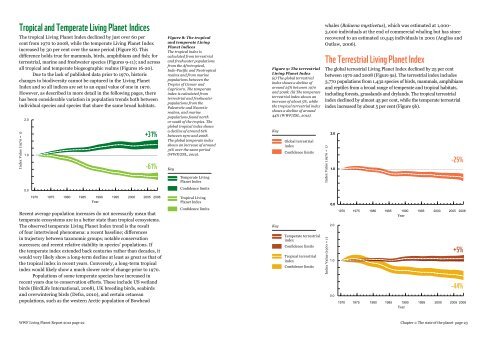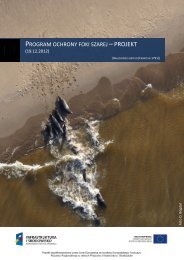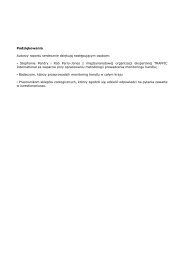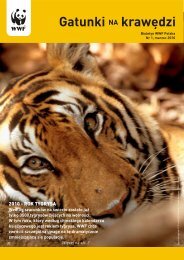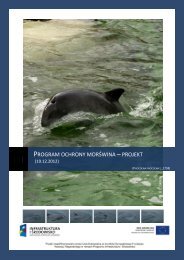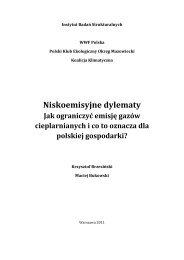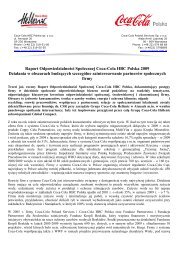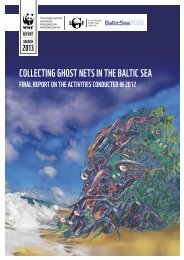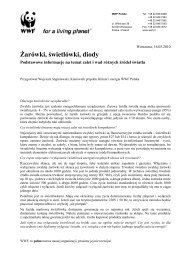Biodiversity, biocapacity and better choices
Biodiversity, biocapacity and better choices
Biodiversity, biocapacity and better choices
You also want an ePaper? Increase the reach of your titles
YUMPU automatically turns print PDFs into web optimized ePapers that Google loves.
Tropical <strong>and</strong> Temperate Living Planet IndicesThe tropical Living Planet Index declined by just over 60 percent from 1970 to 2008, while the temperate Living Planet Indexincreased by 30 per cent over the same period (Figure 8). Thisdifference holds true for mammals, birds, amphibians <strong>and</strong> fish; forterrestrial, marine <strong>and</strong> freshwater species (Figures 9-11); <strong>and</strong> acrossall tropical <strong>and</strong> temperate biogeographic realms (Figures 16-20).Due to the lack of published data prior to 1970, historicchanges to biodiversity cannot be captured in the Living PlanetIndex <strong>and</strong> so all indices are set to an equal value of one in 1970.However, as described in more detail in the following pages, therehas been considerable variation in population trends both betweenindividual species <strong>and</strong> species that share the same broad habitats.Index Value (1970 = 1)2.01.00.0+31%-61%Figure 8: The tropical<strong>and</strong> temperate LivingPlanet indicesThe tropical index iscalculated from terrestrial<strong>and</strong> freshwater populationsfrom the Afrotropical,Indo-Pacific <strong>and</strong> Neotropicalrealms <strong>and</strong> from marinepopulations between theTropics of Cancer <strong>and</strong>Capricorn. The temperateindex is calculated fromterrestrial <strong>and</strong> freshwaterpopulations from thePalearctic <strong>and</strong> Nearcticrealms, <strong>and</strong> marinepopulations found northor south of the tropics. Theglobal tropical index showsa decline of around 61%between 1970 <strong>and</strong> 2008.The global temperate indexshows an increase of around31% over the same period(WWF/ZSL, 2012).KeyTemperate LivingPlanet IndexConfidence limitsFigure 9: The terrestrialLiving Planet Index(a) The global terrestrialindex shows a decline ofaround 25% between 1970<strong>and</strong> 2008; (b) The temperateterrestrial index shows anincrease of about 5%, whilethe tropical terrestrial indexshows a decline of around44% (WWF/ZSL, 2012).KeyGlobal terrestrialindexConfidence limitswhales (Balaena mysticetus), which was estimated at 1,000-3,000 individuals at the end of commercial whaling but has sincerecovered to an estimated 10,545 individuals in 2001 (Angliss <strong>and</strong>Outlaw, 2006).The Terrestrial Living Planet IndexThe global terrestrial Living Planet Index declined by 25 per centbetween 1970 <strong>and</strong> 2008 (Figure 9a). The terrestrial index includes3,770 populations from 1,432 species of birds, mammals, amphibians<strong>and</strong> reptiles from a broad range of temperate <strong>and</strong> tropical habitats,including forests, grassl<strong>and</strong>s <strong>and</strong> dryl<strong>and</strong>s. The tropical terrestrialindex declined by almost 45 per cent, while the temperate terrestrialindex increased by about 5 per cent (Figure 9b).Index Value (1970 = 1)2.01.0-25%1970 19751980 1985 1990 1995 2000 2005 2008YearRecent average population increases do not necessarily mean thattemperate ecosystems are in a <strong>better</strong> state than tropical ecosystems.The observed temperate Living Planet Index trend is the resultof four intertwined phenomena: a recent baseline; differencesin trajectory between taxonomic groups; notable conservationsuccesses; <strong>and</strong> recent relative stability in species’ populations. Ifthe temperate index extended back centuries rather than decades, itwould very likely show a long-term decline at least as great as that ofthe tropical index in recent years. Conversely, a long-term tropicalindex would likely show a much slower rate of change prior to 1970.Populations of some temperate species have increased inrecent years due to conservation efforts. These include US wetl<strong>and</strong>birds (BirdLife International, 2008), UK breeding birds, seabirds<strong>and</strong> overwintering birds (Defra, 2010), <strong>and</strong> certain cetaceanpopulations, such as the western Arctic population of BowheadTropical LivingPlanet IndexConfidence limitsKeyTemperate terrestrialindexConfidence limitsTropical terrestrialindexConfidence limitsIndex Value (1970 = 1)0.02.01.00.01970 19751970 19751980 1985 1990 1995 2000 2005 2008Year+5%-44%1980 1985 1990 1995 2000 2005 2008YearWWF Living Planet Report 2012 page 22 Chapter 1: The state of the planet page 23


